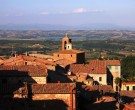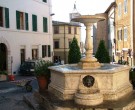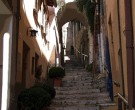> Home > What to visit > Old Town

Chianciano Terme Chianciano Terme
OLD TOWN

PHONE NUMBERS AND TIMES
Chianciano Terme
Business card (vCard)
The beneficial quality of the mineral water of this town was already appreciated by the Etruscans and the Romans, that had steadfastly inhabited the area, building an important populated center. The presence in this territory of many burial vaults makes one think of a settlement, maybe more than one, gravitating around the town of Chiusi. But while Chiusi reached the maximum splendor in the V century B.C., Chianciano and the surrounding area are full of ruins from the Bronze and Iron Ages. The Neolithic settlement of Chiarentana, at the foot of Mount Cetona, where the foundations of some huts with remainders of ceramics and obsidian material have been discovered , is worth visiting. The discovery of these objects testifies a rich commercial exchange existing with the pontine archipelago, and especially with the Isle of Palmarola, area rich in obsidian material. At the end of the Iron Age (X – IX century B.C. ) on these hills that look on the Val d’Orcia, a rich and quite populated settlement developed. No trace exists at the moment, but the settlement probably existed. To testify such theory is the rich necropolis that has been undergoing excavations since 1900. The Geo-Archeological Society of Chianciano Terme began the excavations at that time, in a vast area situated at La Foce, bringing to light over 700 tombs , that go from the beginning of the VII century to the end of the VI century B.C. There are vase shaped tombs ( where the ashes and the trousseaus are contained in great clay vases), rectangular shaped tombs ( parallelepipidal containers made of stone with the same function of the vases) and chamber tombs dug out of tufo. The peculiarity of this necropolis is due to the presence of such a great number of sepulchers and to the richness of the material that they contain. As a matter of fact, whereas in this area there are several hundred tombs, in the territory of Chiusi, always dated about the same period , only about seventy sepulchers have been brought to light. The presence of such a populated center , so large for that period , is due to the strategic position where it stood : close to a passage 500 meters high ,where the ancient Rosellana, the main connecting artery among the coast towns and the interior Etruria (Chiusi, Perugia, Cortona, Arezzo) passed through. Of remarkable interest are the materials that these tombs contain: achromatic Etruscan clay pottery, pottery in “bucchero” (a typical Etruscan technique), bronze and silver jewels (rings, bracelets, necklaces). The most recent tombs frequently contain imported Attic and Corinthian vases. Anyway, what makes this necropolis so important, is the discovery of about seventy canopies, fictile sculptures that have the shape of the head of the deceased , supported by a “throne” and containing the ashes of the dead person. The necropolis at Foce was abandoned in the V century B.C., although it was sporadically used during the Hellenistic period. At this time, another necropolis , situated in the Pedata-Morelli area ,starts developing. It consists of sepulchers with very large chambers, often with several chambers in each tomb, with very rich trousseaus. From this area come a few cinerary statues made of fetid stone , preserved at the Archeological Museum in Florence, among these the famous Mater Matuta, funerary landmarks and other material. The bronze material, of elegant manufacture , is quite important. This complex funerary system belongs to an aristocratic branch of landowners, often in conflict with the society in the territory of Chiusi. During the Hellenistic period many sanctuaries dedicated to the water divinities took shape, although some were already present in the area. Among these, the most famous is the Temple of Fucoli; discovered on the homonymic hill, with part of its clay friezes with mythological scenes still existing. But it’s at this time that the Etruscan civilization starts decaying, be it for internal problems or for the ever increasing Romanization. The Romans divided the territory of Chianciano in large estates, that contributed to eliminate the class of the small landowners, that during the Etruscan period corroborated with the nobility. The late Etruscan farm of Poggio Bacherina, with basins for the production of oil and wine, dates back to such period. Whereas, the thermal baths settlement of Mezzomiglio and the cistern of Camerelle date back to the Roman period.
STAY NEARBY
La locanda degli Artisti
CHIANCIANO TERME
Il nostro B&b è situato in una posizione privilegiata, una piccola oasi, abbrac...SANTA CATERINA
CHIANCIANO TERME
Welcome to Hotel SANTA CATERINA in Chianciano Terme, the ideal accommodation for your plea...PIETRICCIA
CHIANCIANO TERME
Piccola azienda agricola a conduzione familiare, di circa 5 ha. di vigneto e uliveto. con ...DINING & ENTERTAINMENT NEARBY
Centro Polisportivo
CHIANCIANO TERME
E’ situato in prossimità del centro storico e circondato da verde pubblico. ...Acqua Sant'Elena, Centro Termale
CHIANCIANO TERME
La Sorgente Sant'Elena è stata fondata nel 1925. E`situata su di una collina, imme...Tribeca Restaurant
CHIANCIANO TERME
The Tribeca Restaurant concept arose in order to start an upmarket restaurant which would ...






